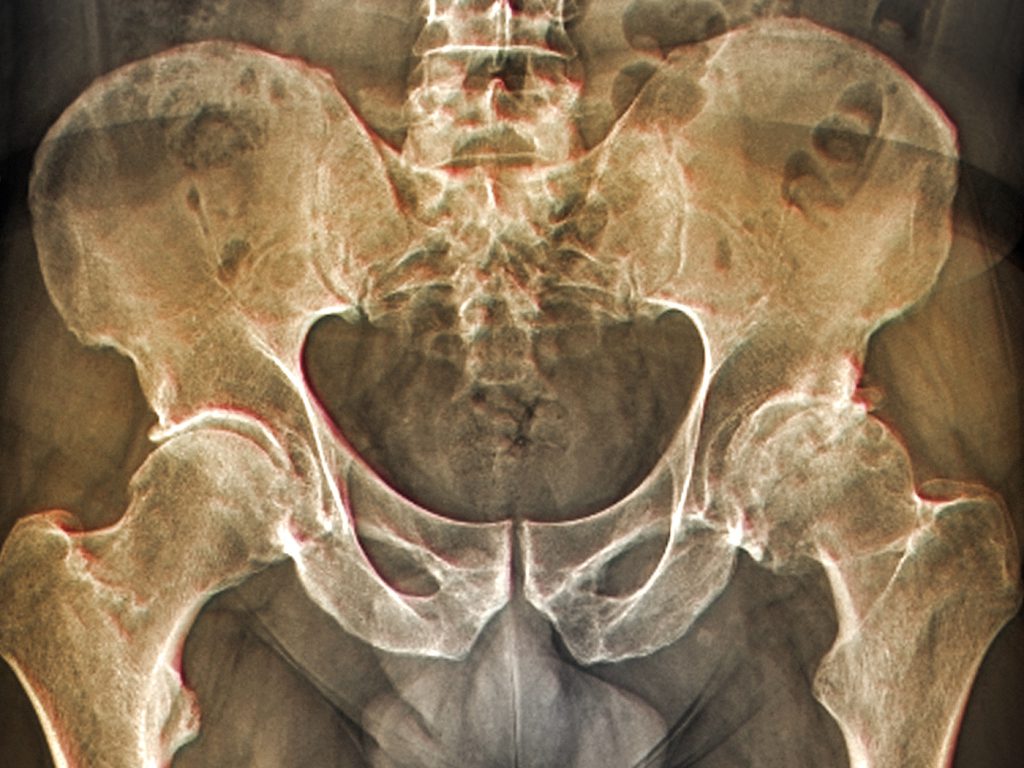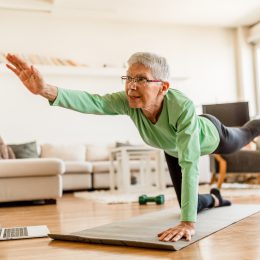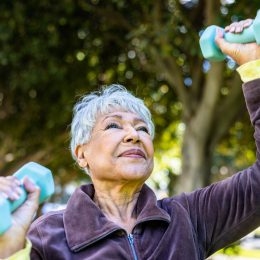How to Exercise for Osteoporosis: 4 Rules to Follow
Here’s what you should—and shouldn’t—do to keep bones strong and avoid fractures.

If you have osteoporosis, you may worry that being active means you’re more likely to fall and break a bone. But the opposite is true. Regular exercise with a properly designed program can help prevent falls and fractures. That’s because exercise strengthens bones and muscles, and improves balance, coordination, and flexibility—all key for people with osteoporosis.
The problem is that guidelines for exercising with osteoporosis are not crystal clear. In general, “you want to do exercises that improve or maintain bone density in the way of strength or resistance training and also include impact-style aerobic exercise,” says Karen Kemmis, D.P.T., an expert for the National Osteoporosis Foundation.
But how much impact is safe? And should certain exercises always be avoided?
The answers to these common questions depend on your history of fractures and the severity of your osteoporosis, Kemmis says. “If somebody has had a fracture with no trauma or low trauma, meaning there wasn’t an obvious incident to cause it, then we have to be careful and stick with low- to no-impact exercise,” she says. (See the eight best low-impact workouts for older adults.)
On the other hand, someone who does not have severe osteoporosis and has no history of fractures or other injuries can do higher-intensity exercise. “But that doesn’t mean power lifting,” Kemmis says. It means things like brisk walking or dancing.
If you’re not sure about the severity of your osteoporosis, talk to your doctor about a bone mineral density scan or revisit the results if you’ve already had one. This test scans the most common sites of bone loss, most notably hips and spine. “We look at four segments of the lumbar spine,” Kemmis says, referring to the lower back. “It’s the only part of the spine we can assess because the ribs get in the way of the test, but we assume what’s going on with this part of the spine is also going on with the rest of the spine.”
The type of bone in the spine also tends to change more quickly with age, so osteoporosis may show up there first. “Interestingly, arthritis of the spine can give a false reading on a scan, since a bone spur from arthritis may appear as a denser part of the bone but doesn’t mean the bone is actually stronger,” Kemmis says. So be sure to notify your doctor if you have arthritis to confirm an accurate reading.
How to Choose the Right Form of Exercise
Exercising with osteoporosis means finding the safest, most enjoyable activities for you given your overall health and amount of bone loss. There’s no one-size-fits-all prescription, which is why it’s important to check with your doctor or physical therapist before you start a new workout program. That said, here are some general guidelines to follow when exercising with osteoporosis.
And if you haven’t yet, be sure to check your eligibility for free access to gyms and exercise classes nationwide through SilverSneakers. Check your eligibility and find locations here.
1. Strengthen Your Muscles
Strengthening your muscles can slow the bone loss that happens with osteoporosis and may help prevent fall-related fractures. Your workouts should revolve around functional movements, like squats, lunges, and pushups, and may incorporate free weights, exercise bands, machines, or just your own body’s weight as resistance.
Kemmis recommends lifting in a range of eight to 12 reps and making proper form your top priority. “Using even light weights with poor posture can be dangerous for someone with osteoporosis,” she says. If the back is curved in a flexed posture while a weight is lifted, it can put strain in the vertebrae, which could result in a compression fracture. If you have perfect posture, you can tolerate much more.
“The challenge is you often don’t know you’re injured until it’s too late,” Kemmis says. “Good posture, proper body mechanics, and keeping a neutral spine and not bending forward are most important.” If you’re not sure you should do a certain exercise, don’t. “You’re better to be safe than sorry.”
If you’re new to strength training, click here for everything you need to know to get—and stay—strong through the years.
2. Use as Much Impact as You Can Tolerate
This rule applies to weight-bearing aerobic activities, which involve doing aerobic exercise on your feet, with your bones supporting your weight. These types of exercise work directly on the bones in your legs, hips, and lower spine to slow mineral loss. They also provide cardiovascular benefits, which boost heart and circulatory system health.
Weight-bearing aerobic exercise is an important element of your overall routine, but it’s up to you to select the appropriate amount of impact based on your health care team’s recommendations and your comfort level.
Depending on the degree of osteoporosis and baseline activity level, you might start out with low-impact exercise, like using an elliptical, says David Geier, M.D., a sports medicine physician and orthopedic surgeon in Charleston, South Carolina. “Then you can advance to higher levels of impact, like jogging, hiking, stair climbing, or aerobics classes.”
While swimming and cycling have many benefits, they don’t provide the weight-bearing load your bones need to slow mineral loss. However, if you enjoy these activities, do them. Just be sure to also add weight-bearing activity as you’re able.
Another tip: To spread the stress and impact to different parts of the body, Dr. Geier recommends cross training, or doing different types of exercises in any given week. For example, you could do the elliptical on Monday, resistance exercises on Tuesday, swimming on Wednesday, and so on.
Subscribe to our newsletter
It's quick and easy. You could be one of the 13 million people who are eligible.
Already a member? Click to discover our 15,000+ participating locations.
Follow Us
“And always stop if pain develops and get checked out by a doctor,” Dr. Geier adds.
3. Allow Your Body Enough Time to Heal
Jogging or doing any high-impact exercise daily or nearly every day may not allow your body enough time to heal, Dr. Geier says. “You already have decreased bone density, so the repetitive stress without enough time to heal the microscopic bone damage could build up and lead to a stress fracture,” he says.
Allow at least one full day between high-impact exercise, and gradually increase the number of workouts you do each week. Again, cross training by mixing in different types of workouts helps reduce the risk of fracture.
4. Avoid Forward Bends and Twists
Yoga and Pilates are helpful for stretching and lengthening, but they also include forward-bending and twisting movements that can strain the spine. Any movement involving extreme spinal flexion, or forward bend, creates compression between the vertebrae and can trigger a “cascade of fractures,” Kemmis says. “Hinging forward at the hips is different than rounding your back and compressing the spine, which is more dangerous.”
You’ll want to avoid yoga or Pilates movements that involve bending forward or rotating the trunk:
- Rollup, rollover, or rolling like a ball
- Teaser or open leg rocker
- Corkscrew or bicycle
- Spine twist or any deep twists
- Pigeon pose or deep hip stretches
- Assisted stretching from teachers to increase range of motion
This doesn’t mean you can’t enjoy your favorite classes. Exercises like planks, spinal extensions (cobra pose), and balance moves (tree pose) can be safe and help improve strength. Be sure to arrive a few minutes early to talk to your instructor about your limitations. He or she will be able to provide recommendations or modifications to keep you safe—while still getting a great workout.
Check Your SilverSneakers Eligibility Instantly
SilverSneakers gives you free, unlimited access to more than 16,000 gyms and fitness centers across the nation, plus classes and tools designed to keep older adults strong and independent. Check your eligibility instantly here.
Already a member? Get your SilverSneakers member ID and exclusive content by logging in to or creating your online account here.




